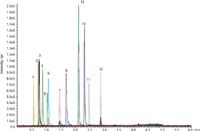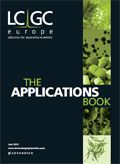Rapid LC–MS–MS Analysis of Heterocyclic Amines in Salmon
Phenomenex Application Note
Heterocyclic amines (HCAs) are a class of compound that are formed when amino acids from meat proteins react with glucose and creatine under high-temperatures, as is associated with frying or grilling over an open flame (1–3). Studies have correlated the consumption of high levels of HCAs with an increased risk of some forms of cancer. Though this has only been demonstrated in animal models, investigations into the possible correlation between cooked meat consumption and elevated cancer risks will continue in both Europe and the United States (1).
Analysis of HCAs in food products can be challenging due to a number of factors including: (1) their relatively low level in food products, necessitating the use of highly sensitive techniques such as LC–MSMS, (2) the complex nature of the sample matrix, which can compromise HPLC column lifetime and confound analysis and (3) the basic nature of these analytes, which can lead to peak tailing issues. Herein, we present a sensitive method for the analysis of HCAs which utilizes solidphase extraction (SPE) for cleanup and a sub-2µm core-shell UHPLC column for the subsequent LC–MS-MS analysis.

Figure 1: Representative chromatogram of 12 eterocyclic amines analysed using a Kinetex 1.7µm C18 core-shell UHPLC column.
Experimental Conditions
Sample Preparation and Solid-phase Extraction:
For detailed sample preparation and SPE conditions, please contact Phenomenex. In brief, salmon tissue meat purchased from a grocery store was pulverized and then spiked with a mixture of HCAs and appropriate internal standards at a final concentration of 25 ng/g of tissue. This mixture was then subject to liquid-liquid extraction using hexane and acetonitrile. The aqueous acetonitrile layer was recovered for subsequent solid-phase extraction using a polymer-based strong cation-exchange cartridge (Strata™ -X-C 60 mg/3 mL).

Figure 2: A representative extracted ion chromatogram for 7,8- and 4,8-dimethyl IQx, isomeric HCAs that must be baseline-resolved to enable accurate quantitation using LCâMS-MS.
LC–MS–MS Conditions:
Column: Kinetex® 1.7µm C18 with SecurityGuard™ ULTRA C18
Dimensions: 50 × 3.0 mm
Mobile phase: A: 30 mM Ammonium formate; B: Acetonitrile
Gradient: (80:20) A/B to (40:60) A/B in 3 min, then step to 100% B and hold for 1 min, then re-equilibrate at (80:20) A/B for 1min
Flow-rate: 600µL/min
Column temperature: Ambient
Detection: MS using API 4000™ detector
Injection concentration: 25 ng/mL
Sample:
1. IQx
2. 8-MeIQx
3. IQ
4. 7,8-DiMeIQx
5. 4,8-DiMeIQx
6. MeIQ
7. Trp-P-2
8. Harman
9. PhIP
10. Norharman
11. AαC
12. MeAαC
References
(1) http://www.cancer.gov/cancertopics/factsheet/Risk/cooked-meats
(2) P. Arvidsson et al., J. of Food Science, 64(2), 216–221 (1999).
(3)T. Sugimura et al., Cancer Sci., 95(4), 290–299 (2004).
Phenomenex Inc.
411 Madrid Avenue, Torrance, California 90501, USA
tel. +1 (310) 212-0555, +1 (310) 328-7768
Website: www.phenomenex.com

New Study Reviews Chromatography Methods for Flavonoid Analysis
April 21st 2025Flavonoids are widely used metabolites that carry out various functions in different industries, such as food and cosmetics. Detecting, separating, and quantifying them in fruit species can be a complicated process.
Analytical Challenges in Measuring Migration from Food Contact Materials
November 2nd 2015Food contact materials contain low molecular weight additives and processing aids which can migrate into foods leading to trace levels of contamination. Food safety is ensured through regulations, comprising compositional controls and migration limits, which present a significant analytical challenge to the food industry to ensure compliance and demonstrate due diligence. Of the various analytical approaches, LC-MS/MS has proved to be an essential tool in monitoring migration of target compounds into foods, and more sophisticated approaches such as LC-high resolution MS (Orbitrap) are being increasingly used for untargeted analysis to monitor non-intentionally added substances. This podcast will provide an overview to this area, illustrated with various applications showing current approaches being employed.

.png&w=3840&q=75)

.png&w=3840&q=75)



.png&w=3840&q=75)



.png&w=3840&q=75)















